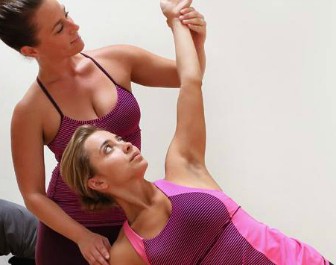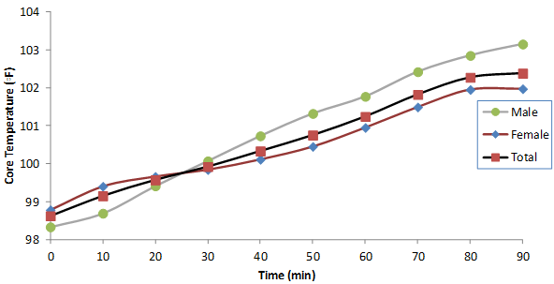How Safe Is Today's Hottest Fitness Trend?

But in this sauna of a room set to a temperature of 105 degrees, even such a beginner pose challenges my tenacity and strength. By the end of the class, I can’t tell whether I feel at ease with my inner psyche or grateful that I’m finally allowed to get the hell out of there. Whichever it is, I sign up for another Bikram yoga class the next week, prepared to sign my soul over to yet another culty exercise fad.
Across the yoga field, almost no instructor will tell you flat out that Bikram is 100 percent good for you. “There are benefits and there are challenges with [Bikram] yoga,” said Brigitte Kouba, a Santa Monica-based yoga instructor who teaches vinyasa flow in rooms that are never artificially heated.
Kouba used to practice Bikram when she lived in the frigid state of Colorado, but finds no need for it now that she’s relocated to Los Angeles. Her own experience with Bikram is exemplary of the advice she gives to her students — to listen to their own bodies’ signals. If it doesn’t feel good, she said, don’t do it.
According to Bikram yoga’s official website, the practice is held in a room kept at 104 degrees Fahrenheit and is made up of 26 poses, including the half moon pose and tree pose. The founder of the routine, Bikram Choudhury, even himself refers to the scorching rooms where the yoga is held as “Torture Chambers,” so the question remains: Why are people so strongly attracted to this practice, myself included?
READ MORE: Tradition Turned Trend: Yoga’s Westernization
Surprisingly, the reason many are drawn to practicing yoga in such high temperatures may be more mental than physical. One 2011 study conducted by researchers at Boise State University found that after 8 weeks of Bikram yoga, participants’ stress levels were reduced by 28 percent.
“The current study suggests that Bikram yoga alone may be effective for improving mindfulness when compared to programs combining yoga with other techniques for the purpose of mindfulness-training based stress reduction,” the study authors wrote in their published results. Other researchers have found similar effects on the mind — some on test subjects, and some in their own Bikram practice.
“I like how much you have to focus your efforts and the discipline of [Bikram yoga],” said Brian Tracy, Ph.D., director of the Neuromuscular Function Lab at Colorado State University and himself a yogi. While Tracy’s research has focused more on Bikram’s physical effects on heart and body health, he speculates that most participants are, as he is, drawn to the clarity and mindfulness of the practice. “Many people experience a dramatic mental effect: decreased stress, improved mood, etc,” said Tracy. “People are attracted to something that is difficult and that requires a lot of them.”
John Porcari, Ph.D., executive director of the La Crosse Exercise and Health Program at the University of Wisconsin at La Crosse and not a regular practitioner of Bikram, feels as if the addition of heat to yoga has therapeutic effects similar to that of a sauna. “Why do people go in a sauna?” Porcari asked rhetorically. “It gets rid of anxiety. There’s something about the heat and sweating; you’re almost like a dish rag.”
READ MORE: 29 Thoughts Everyone Has During Their First Yoga Class
Porcari may not practice Bikram, but he is interested in the practice enough to have conducted several studies on it. In conjunction with the American Council on Exercise (ACE), he studied the impact of both Bikram yoga and hot yoga, a shorter, refined version of the practice, on participants’ core body temperatures.
While he and his team found no abnormal spikes during the hot yoga class, Bikram yoga steadily raised core body temperatures and Porcari’s concerns. During his study, core temperatures reached a high of 104.1 degrees and seven of the 20 participants reached a core temperature above 103 degrees.

The problem with such high temperatures is that they increase the risk for heart complications and other problems, especially for older individuals and those with chronic conditions, Porcari explained. Instructors recommend that individuals with diabetes, high blood pressure or obesity pay careful attention to their bodies’ response to Bikram, as these conditions can prevent the body from adequately regulating its internal temperature.
“Especially with people of poor health and fitness or who have pre-existing health conditions, excessive heat and humidity can be very risky and life-threatening,” said Steve Hsu, a yoga instructor and professor at the University of Southern California. Hsu recalled a time when a 56-year-old student asked his opinion on whether she should take up Bikram yoga, but to both their dismays did not heed his advice. “One week later, she came to me absolutely disgruntled that she attended and said she would never go back to that class or another Bikram yoga class again.”
Few studies aside from Porcari’s have been done on the effects of Bikram yoga on our bodies, but they must be if we plan to better understand the practice. Unfortunately, the majority of research currently available is funded by places like ACE and Bikram Yoga College, which is run by Choudhury himself, and needs to be considered with a grain of salt. And research on Bikram yoga is not only sparse, but also disputed among researchers in this small community.
READ MORE: The Health Benefits Of Yoga
Tracy, who conducted an internal body temperature study similar to Porcari’s, has publicly expressed his criticism of Porcari’s research on his Facebook page, and told me that it was “very poorly done and thus should not be considered.” In his post, he lists his qualms with Porcari’s research, including “inadequate control over hydration status” and no description of the clothing worn by the subjects, which could contribute to overheating.
In response to the complaints, Porcari issued a rebuttal responding to the accusations for ACE to review, which they found to be adequate. Professor Porcari notes that if he were to conduct the study again, the only thing he would do differently is “measure body weight before and after the class.” Tracy’s complaints have some merit; however, his criticisms may have an ulterior motive, given that his own research was funded by Bikram Yoga College and resulted in lower core body temperatures that look better for the practice.
No matter which study you refer to, both show that core body temperatures will steadily rise to some degree after a Bikram yoga class. When I asked Porcari how studios might make their practices safer, he suggested “shortening classes, drinking more fluids and climatizing classes.” One of the biggest problems he saw during Bikram yoga was that teachers never encouraged their students to take a water break, and many yogis consider it “a badge of honor” to deprive themselves of fluids.
“There is absolutely nothing to be gained by holding fluids from someone,” Porcari said. “Just because you can tolerate something doesn’t mean you should.”
Thankfully for hardcore Bikram fans, other studies have shown benefits of practicing in a heated room compared to traditional yoga. After assessing the short-term physical effects of Bikram on healthy adults, Professor Tracy and his team found that participants became more flexible likely due to the temperature of the room.
“It is very likely that the heat in the room produces higher tissue temperatures, which contributes to greater extensibility of the muscle and connective tissue,” Tracy said. “This likely allows the stretches to be deeper.”
Greater extensibility may be ideal for someone with stiff muscles, but for a yoga instructor like Brigitte who is already very flexible, this is a cause for real concern. “I’m prone to injury, I’m already incredibly flexible, so just being in a hot space feels unsafe for me,” Kouba said.
READ ALSO: I Took An Aerial Silk Class: This Is What Happened
Some of the other proven rewards of Bikram yoga may have nothing to do with the temperature of the room. While Tracy was also able to show that 8 weeks of Bikram training resulted in an up to 72 percent increase in lower back flexibility and an 18 percent increase in shoulder flexibility, he admits that he cannot determine whether the improvements would also reflect in a study involving yoga at room temperature.
“The other outcomes in the study… were probably not affected by the heat, but more the requirements of the postures,” Tracy said. Unfortunately, no studies have been done to compare regular yoga to Bikram yoga, so whether the temperature plays a significant role in these outcomes is still up in the humid air for now.
Is Bikram yoga a dangerous practice? With proper guidance and adequate hydration, research shows that a healthy individual should walk out of a 90-minute class alive and well, and perhaps even a little less stressed.
Reach contributor Morgan Greenwald here.



